Abstract
Tourism activities are highly dependent on climatological conditions. The climatological suitability of tourism destinations is investigated by using a Tourism Climate Index (TCI) that is frequently used by researchers. The TCI varies between 0 and 100 and is created by using temperature, relative humidity, sunshine duration, wind and precipitation data. For TCI, 100 is for ideal and 0 is for extremely unfavorable conditions for tourism. In this study, the meteorological data covering the period of 1981–2020 for 98 stations is used to calculate the TCI of each station for all seasons and months. The Mann-Kendall trend test is used for TCI behavior of the entire country and Sen Innovative Trend Analysis method is used for four famous tourism destinations. For summer, coastal regions have smaller TCI values than inland regions due to the high amount of relative humidity. Most stations have TCI values in the “Very Good” category or better. In spring and autumn, the TCI values fall into the “Acceptable” category or better. The winter is the season with smallest TCI values. For summer, 54 of 98 stations have a decreasing trend at different levels of significance and four of them have an increasing trend. In autumn, 30 stations have an increasing trend and two stations have a decreasing trend at standard levels of significance. Similarly, for spring, 20 stations have an increasing trend and one has a decreasing trend. During winter, 14 stations have an increasing trend while one has decreasing trend. The Sen Innovative Trend test shows an increasing trend on average for four famous tourism destinations during May–September months.
1. Introduction
Tourism is one of the important factors in global economic growth and development. The World Travel and Tourism Council (WTTC) mentioned that tourism contributed to the World Gross Domestic Product (GDP) as much as 10.4% and 319 million people were employed in the industry [1]. The WTTC states that tourism corresponds to 2–12% of GDP. In some developing economies and island economies, it corresponds to 40% to 70% of GDP, respectively. It is mentioned that approximately 10% of employment is related to the tourism sector all over the world [2].
As it is worldwide, tourism is also one of the main sources of income in Türkiye. In 2019, the total number of visitors was 61 million and foreign visitors were 45 million. In the same year, tourism income was recorded as USD 34.5 billion. Türkiye ranked 14th in tourism incomes, and it accounts for a share of 2.8% in the international tourism market and 5.6% in the European tourism market. It is expected that an increase will continue in the tourism sector in the following years. It is estimated that, according to the World Tourism Organization (2022), the number of international tourists will reach 1.5 billion and 1.8 billion, respectively, in 2023 and 2030 [3]. In 2030, it is expected that the most frequently visited regions will be Northeastern Asia. It is projected that Southeastern Europe/Mediterranean, to which Türkiye belongs, will be the second most visited region in 2030 [4].
Tourism activities vary based on climatic zones in different regions of Türkiye [5]. Based on seasonal variabilities like other Mediterranean countries, winter and summer tourism have unique characteristics [6]. For tourism, the value of weather and climate is understood all over the world. Climate change directly affects the holiday destination [7,8,9,10], and the duration and quality of holiday [11]. According to the report of Eurobarometer (2012), 50% of European citizens decide on visiting the same holiday destination again based on the weather conditions [12].
Weather conditions and climate affect tourists’ activities and satisfaction [13]. In addition, they are also important for infrastructure and operating costs [14]. While the hot and dry weather in city centers is unfavorable for tourists, the forests and seaside are attractive areas for them [15]. The variables affecting the climate elements are mean, minimum and maximum air temperatures, relative humidity, precipitation, wind speed, sunshine duration and solar radiation values. These variables can be used daily, monthly and annually in related calculations [16].
Mieczkowski (1985) presented an index called the Tourism Climate Index (TCI) which includes seven different climate variables to introduce the effect of climate on tourism [16]. In many studies, this index indicates the effect of climate for tourist destinations [17,18,19]. Since the TCI method includes three main climate aspects, which are thermal comfort, physical aspects and aesthetical facet, it is frequently used in literature [20]. Also, availability of these variables makes this method able to beused widely.
Several climatological studies were conducted for Türkiye [21,22,23]. However, a few studies were performed for the suitable climatological conditions for tourism [6,24]. In this study, the trends in TCI values were analyzed by using Mann-Kendall and Innovative Sen’s Trend tests as the spatio-temporal basis. The goal of this study is to examine the trends of TCI values for 98 stations in Türkiye using two different trend tests. The effect of climate change on tourists’ holiday destinations was investigated for each city as monthly and seasonally. The study is unique, because trend analysis of TCI values for all Türkiye has not been studied yet.
2. Data and Methodology
2.1. Study Area
Türkiye with complex topography is located on two continents, Europe and Asia. The Northeast part of Türkiye is in Europe and the main part of the country is located in Asia. Türkiye is surrounded by the Black Sea to the north, the Aegean Sea from the west and the Mediterranean from the south. Thus, beach tourism is popular and contributes to the Turkish economy [25].Due to the diversity in landforms of Türkiye, it is a good destination for other forms of tourism like skiing or mountain tourism. The focus of the study is to investigate the climate conditions and their contribution to the suitability for tourism activities. The monthly mean of daily maximum temperature (°C), daily mean temperature (°C), daily minimum relative humidity (%), daily mean relative humidity (%), daily sunshine duration (hours), daily mean wind speed (m/s) and monthly sum of daily total precipitation (mm) data are used for TCI calculation, and these are obtained from the Turkish State Meteorological Service (TSMS) for the period of 1981–2020. The raw data includes more than 200 stations. The stations with the data availability of precipitation less than 80% is excluded, so 98 stations are used in this study. The location of the stations used in this study is seen in Figure 1. The altitudes and coordinates of the stations are given in Table 1. The spatial and temporal analysis was stratified by season (December, January, and February for winter; March, April, and May for spring; June, July, and August for summer; and September, October, and November for autumn).
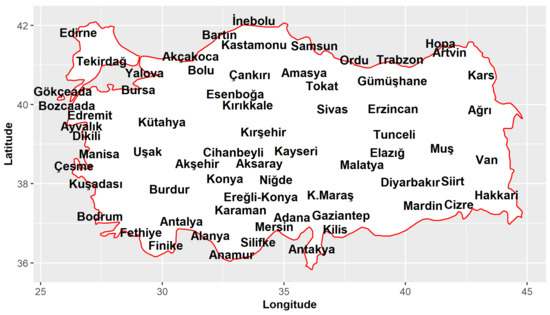
Figure 1.
The stations used in the study.

Table 1.
The altitude, latitude and longitude of the stations.
2.2. Tourism Climate Index (TCI)
Mieczkowski (1985) introduced the Tourism Climate Index (TCI) which combines monthly means of daily mean temperature, daily maximum temperature, daily mean relative humidity, daily minimum humidity, daily sunshine duration and daily mean wind speed and the monthly sum of daily total precipitation [16]. TheTCI is a widely used index in studies [5,26,27]. This index can be evaluated on a scale of −20 to 100 obtained by transforming meteorological variables mentioned above to new sub-indexes. TCI is defined as
where CIDT is comfort index for daytime, DCI is daily comfort index, PRE is precipitation index, SSH is sunshine duration index and WSP is wind speed index. PRE, SSH and WSP sub-indices in the TCI equation get values between 0–5. When the monthly sum of precipitation and monthly mean wind speed approaches 0, PRE and WSP approaches 5. When the monthly mean of daily sunshine increases, SSH increases. CIDT is obtained from the monthly mean of maximum daily temperature and minimum daily relative humidity by using a thermal comfort system which is modified from ASHRAE (1972) standards for effective temperatures [28]. DCI is calculated by using the same chart for monthly mean of daily mean temperature and relative humidity. Typically, CIDT and DCI have a value between −3 to 5. More information about the components can be found in Mieczkowski (1985) [16]. As seen in (1), the highest weight is assigned to the CIDT because the tourist spends time in tourism destinations during daytime. The second highest weights are given to PRE and SSH. When all the components are favorable and obtain the value of 5, TCI is equal to 100. The TCI scale is divided into 10 categories by Mieczkowski (1985) as seen in Table 2 [16]. These categories range from ideal (90–100), excellent (80–89) to unfavorable (10–19) and impossible (−20–9.9). TCI values greater than 50 are acceptable for outdoor activities. Negative TCI values are obtained for the conditions of very low mean and maximum temperatures, high amount of precipitation, high wind speed and low sunshine duration in monthly bases and so it is impossible.
TCI = 2 × [4 × CIDT + DCI + 2 × PRE + 2 × SSH + WSP]

Table 2.
The TCI Classification Scheme adopted from Mieczkowski (1985) [16].
2.3. Mann-Kendall Trend Test
In trend analysis for meteorological variables, non-parametric tests are used instead of parametric tests to eliminate the negative effects related to observation and measurements. The Mann-Kendall Trend Test (MK) [29,30] is also a non-parametric test and is used to determine the trends of meteorological data over a certain period. The S statistic inthe method is calculated by the subtraction of an observation from following observations, iteratively as in (2). S gets the value +1 if the result is positive, −1 if the result is negative and 0 if it is equal to 0. Then, these values (−1, 0, +1) are added cumulatively (3). A value greater than zero indicates an increasing trend, a value less than zero indicates a decreasing trend and a value equal to zero indicates no trend.
Calculating the variance of S (4) is important for finding the significance level, Z. The Z value is obtained by using the calculations defined in (5) and read in the table. The result is multiplied by two to get the p value. If the p value is less than the determined significance level, α demonstrates that there is a trend in the data; otherwise, there is no trend. In other words, if p is less than 0.01, there is a trend at the 0.01 significance level, if it is between 0.01 and 0.05, there is a trend at the 0.05 significance level and if it is between 0.05 and 0.1 there is a trend at the 0.1 significance level. If the p value is greater than 0.1, the trend is not statistically significant.
2.4. Sen Innovative Trend Test
The Şen Innovative Trend Analysis method introduced by Şen (2012) [31], which is a non-parametric trend test, was used to describe trends in four famous tourism destinations of Türkiye: Antalya, Istanbul, Izmır and Mugla. It is widely used by researchers in atmospheric, hydrological and environmental science [24,32,33,34,35]. The method is entirely dependent on visualization. The scatter plot of the time series of the data is plotted by applying the method step-by-step. After the separation of the data into two equal sub time periods, the data from both periods are sorted in ascending order. Then, scatter of these ordered data is plotted in the Cartesian coordinate system with adding the identity (trend free) line. The abscissa is for the data during the first period and ordinate is for the data during the second period. If all the scatter points fall on the identity line, the data is trend free. For adecreasing trend, the points should be located below the identity line, whilst the points should fall above the identity line for an increasing trend. If all the points fall on the line in the upper (lower) triangle, the data has a monotonic increasing (decreasing) trend. y = 1.1x line on upper triangle and x = 1.1y line on lower triangle were added to analyze the magnitude of the trend.
All figures are illustrated via ggplot2 R-package [36]. All necessary data transformations and basic calculations are done via base R and dplyr packages of R [37,38].
3. Results and Discussion
3.1. TCI Conditions
In this section, the average TCI conditions for each of the stations are stratified into seasons and months are given. The numbers of stations for every TCI class stratified into seasons are seen in Table 3.

Table 3.
Number of stations in TCI class* and the summary of TCI values.
3.1.1. Winter
The distribution of TCI values during winter is seen in Figure 2 and Table 2. There is an increasing pattern from north to south with two exceptions. First, the stations in the East Anatolia Region have the smallest TCI values to the terrestrial winter conditions. The second exceptionis stations on the BlackSea coast that have greater TCI values than the inland stations located in south regions. The TCI values also decrease from west to the east compatible with the increasing elevation. Inner parts with high elevations havesmaller TCI values. The TCI values sharply decrease from “Acceptable” to the “Unfavorable” category when moving from the Southeast Anatolia Region to the inner parts of the East Anatolian Regions, which is the mountainous region of Türkiye. A similar, sharp decrease from “Good” to the “Marginal” category is observed in the southernmost part of the country. In winter, 61 of 98 stations have a TCI value smaller than 50 which corresponds to the categories worse than “Acceptable”. Muş has the smallest TCI value of 32. Ağrı, Tatvan, Bingöl and Rize are other stations that have TCI values less than 40. Out of 98 stations, 37 have TCI values greater than or equal to 50. Stations in the southern part of the country have the greatest TCI values for the winter. İskenderun has the greatest TCI value of 62. Adana, Silifke and Mersin are the other stations that have TCI values greater than or equal to 60 that corresponds to the category of “Good”.
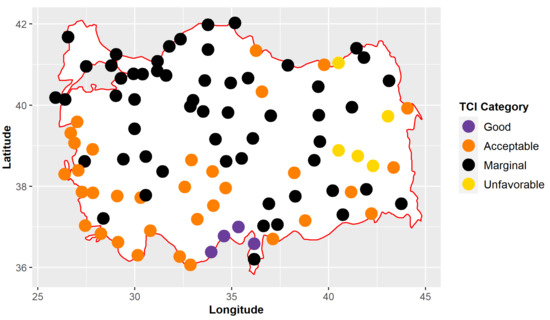
Figure 2.
The TCI distribution for winter.
The TCI distribution of the stations in December is seen in Figure A1 and Table 2. The TCI values range between 35 and 64. There are four stations from the East and Southeast Anatolia Region that have TCI values lower than 40. There are six stations along the shoreline of the Mediterranean and south part of Aegean Region have TCI values greater than 60, that stands for the “Good” category. The rest of the stations have TCI values between 40 and 60. Figure A2 and Table 2 shows the TCI distribution for January. The minimum and maximum TCI values are 30 and 59, respectively. The vast majority of the East Anatolian Region and Rize, The Hopa and Zonguldak stations from the Black Sea coastline have TCI values smaller than 40 that corresponds to “Unfavorable” conditions. Stations in the Aegean and Mediterranean coastline region have TCI values greater than 50 (“Acceptable”). The remaining stations have TCI values that are categorized as “Marginal”. TCI values increase slowly in February over those of January, as in Figure A3 and Table 2. The TCI values range between 32 and 65. There are four stations from the East Anatolia Region with TCI values lower than 40. There are eight stations from the Mediterranean coastline that have TCI values greater than 60 which corresponds to “Good” conditions. The other stations have TCI values between 40 and 60. The TCI values increase from north to south.
3.1.2. Spring
The TCI distribution across Türkiye in spring is seen in Figure 3 and Table 2. The increasing pattern of TCI values from north to the south is clearer. A decreasing pattern from west to the east due to increasing elevation is also clear. TCI values decrease from “Very good” to the “Good” category by moving Central Anatolia to the East Anatolia Region. There is a decrease from “Very good” to the “Acceptable” category in a few hundred kilometers to the increasing elevation. The lowest TCI values are seen in a few stations in the East Anatolia Region. In spring, all the stations have a TCI value greater than 50 that corresponds to the categories better than “Acceptable”. Tatvan has the smallest TCI value of 53. Rize, Erzurum, Kars and Agri have TCI values less than 60. Out of 98 stations, 24 have TCI values in the “Good” category and 54 of 98 stations have TCI values in the “Very good” category. Additionally, 15 of 98 stations have TCI values between 80 and 90, corresponding to the “Excellent” category. Silifke and Mersin are the stations with the highest TCI values of 85 and 84, respectively. Finike and Fethiye have TCI values of 82.
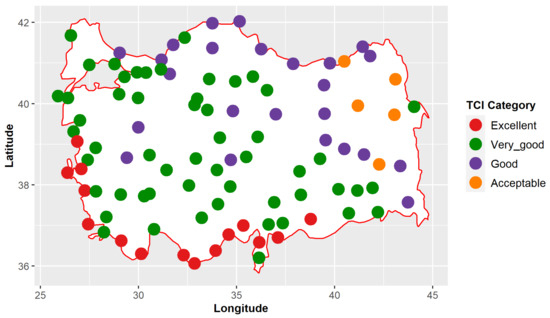
Figure 3.
The TCI distribution for spring.
The TCI distribution of the stations in March is seen in Figure A4 and Table 2. The TCI values range between 39 and 79. Only the Tatvan station from the East Anatolia Region that hasTCI values of 39 is “Unfavorable”. There are 10 stations in the shoreline of the Mediterranean, south part of the Aegean Region and Şanlıurfathat have TCI values greater than 70, that stands for the “Very good” category. In general, TCI values increase from north to south except for the stations in the East Anatolia Region. Figure A5 and Table 2 shows the TCI distribution for April. The minimum and maximum TCI values are 49 and 90, respectively. Four stations from the East Anatolian Region have TCI values smaller than 60, that corresponds to “Acceptable”, and one smaller than 50 that corresponds to “Marginal” conditions. Stations on the Aegean and Mediterranean coastline and in the southeast Anatolia Region have TCI values greater than 80, that stands for “Excellent”. The TCI distribution of the stations in May is seen in Figure A6 and Table 2. The TCI values range between 68 and 93. Kars is the only station that has a TCI value of lower than 70. There are 17 stations that have TCI values between 70 and 80 (“Very good” category). The vast majority (70 stations) of stations are in the “Excellent” category with the value between 80 and 90. The remaining stations are in the “Ideal” category. Dikili, Çeşme and Kuşadası which are in the Aegean coast have the highest TCI value of 93. The TCI values are highest in the southern part of the country, in particular the southern part of the Aegean and Mediterranean coasts. The lowest TCI values belong to the stations in the East Anatolia Region and Black Sea Coast.
3.1.3. Summer
Figure 4 and Table 2 represent the TCI values for stations during the summer season in this study. A different pattern is observed in summer. The terrestrial cities have higher TCI values than coastal cities in general. The TCI values decrease from north to south for coastal stations. The lowest TCI values for terrestrial cities are observed in the southern Anatolia Region. Cizre has the lowest TCI value of 57 that corresponds to the “Acceptable” category. Hopa, Adana and Rize are the following stations with the lowest TCI with the values of 62, 62 and 63, respectively. Twenty of 98 stations are in the “Good” category while 34 are in “Very good” and 39 are in “Excellent” category. Sivas, Nevsehir, Yozgat and Van had the greatest TCI values in the “Ideal” category with the value of 90, 90, 90 and 93, respectively.
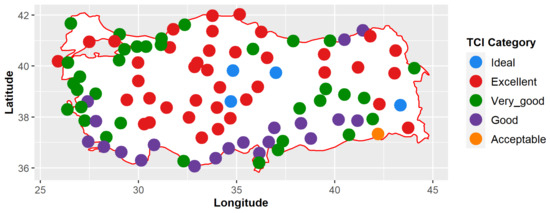
Figure 4.
The TCI distribution for summer.
Figure A7 and Table 2 shows the distribution of TCI values of the stations in June. The TCI values range between 65 and 95. The lower and upper boundaries are like the boundaries of May. Cizre and Hopa have the lowest TCI values of 65 and 69, respectively, that fall in the “Good” category. There are29 stations that have TCI values between 70 and 79, which correspond to the “Very good” category. Also, 55 stations are in the “Excellent” category with the values between 80 and 89. The number of stations in the “Ideal” category in June is higher than May, with the number of 12. Van and Hakkari have the highest TCI values of 95. The TCI distribution pattern that can be described as low TCI values are on the Mediterranean coast and in the South Anatolia Region, medium TCI values are on the Black Sea Coast and the high TCI values are seen in inland areas. Figure A8 and Table 2 shows the distribution of TCI values in July. The minimum TCI value in July is less than May and June. The minimum TCI value belongs to Cizre of 53 and maximum belongs to Van of 93. Twenty-sevenstations are in the category of “Good” whilst 29 are in the “Very good” and 38 are in the “Excellent” category. Erzurum, Yozgat and Van are the stations in the “Ideal” category with the values of 90, 91 and 93, respectively. During July, similar to June, the stations in the Central Anatolia Region have higher TCI values whilst stations in the north part of the country have middle values and the southern stations have lower values. TCI distribution of Türkiye in August is seen in Figure A9 and Table 2. The TCI values range between 55 and 92. Cizre has the lowest TCI value of 55. Also, eight stations are in the “Acceptable” category. Additionally, 23 stations are in the “Good” category, whilst 31 in the “Very good” and 32 are in the “Excellent” category. Only four stations are in the “Ideal” category. Van and Yozgat have the highest TCI values of 92. August has a similar pattern with June and July. Stations in inner-Anatolia have higher TCI values whilst stations on the Black Sea Coast have middle values and the southernmost stations have lower values.
3.1.4. Autumn
The TCI conditions of Türkiye for the autumn season are seen in Figure 5 and Table 2. TCI values in autumn have a narrower range than winter with a minimum of 60 and maximum of 80. Rize, Hopa and Tatvan are the stations with the lowest TCI values of 60, 60 and 63, respectively. There are 14 stations in the “Good” category and 82 stations are in the “Very good” category. Only two stations,Çeşme and Kuşadası, have TCI values of 80 that fall in the “Excellent” category. The pattern for the TCI values in autumn can be described as increasing values from north to the south in general with some exceptions: maximum TCI values are observed in the stations of İzmir and a few stations in the East Anatolia Region with lower values than northernmost stations.
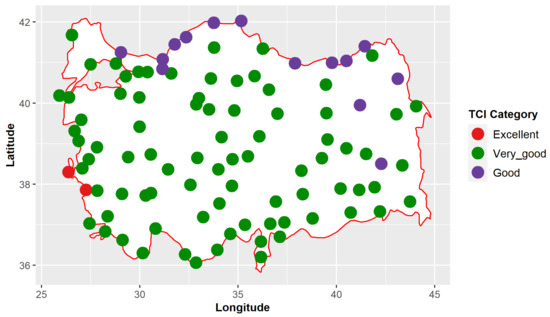
Figure 5.
The TCI distribution for autumn.
For September, the TCI distribution for the stations in the study is shown in Figure A10 and Table 2. The TCI values are increasing during September. The values range between 63 in İskenderun and 94 in Van and Hakkari. Seven stations are in the “Good” category, 28 in the “Very good” and 45 in the “Excellent” category. Also, 18 stations are in the “Ideal” category, the highest number in the ideal category across all months. The TCI distribution pattern is slightly more complex than other warm months. The higher values are in the inner regions, but lower TCI values are observed in both the Black Sea and on the Mediterranean coast. TCI distribution in October is seen in Figure A11 and Table 2. The minimum TCI value of 62 is observed in Tatvan in the East Anatolia Region and a maximum TCI value of 87 is observed in Kuşadasıon the Aegean coast. Additionally, 11 stations have TCI values in the “Good” category, 43 are in the “Very good” and 44 stations are in the “Excellent” category. In general, inner parts of the country have greater TCI values than the Black Sea Region. In November, TCI values decrease for the whole country as seen in Figure A12 and Table 2. The TCI values range between 43 and 77. The East Anatolia Region, Black Sea Region except Samsun Station, Thrace region of Türkiye and the vast majority of inner-Anatolia have TCI values smaller than 60. The Mediterranean Region, Aegean Region and Southeast Anatolia Region have TCI values greater than 60.
3.2. Trend Analysis
The number of stations with trends at different levels of significance are shown in Table 4.

Table 4.
The number of stations with trends at different level of significance.
3.2.1. Winter
Figure 6 and Table 3 show the trend analysis results of TCI values for winter. As seen in Figure 6, 14 stations have an increasing trend for the winter period. On the other hand, only one station (Muğla) which is in the southwestern part of Türkiye has a decreasing trend with 10% of significance level. In addition, the remaining stations have no statistically significant trend in TCI values for winter. There are seven out of 14 stations that have an increasing trend at the 10% significance level while four of them are at the 5% significance level. In addition, three stations have a decreasing trend at the 1% significance level. According to the test statistics, the Kars station, which is located in the Eastern Anatolia Region, and the Cihanbeyli station, which is located in the Central Anatolian Region, have higher increase amounts.
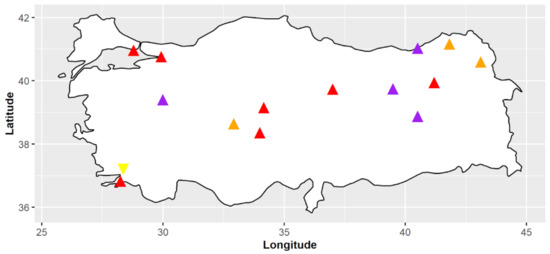
Figure 6.
Mann-Kendall trend results of TCI values for winter (Red upper triangle denotes increasing trend at the 10%significance level, purple upper triangle denotes increasing trend at the 5% significance level, brown upper triangle denotes increasing trend at the 1% significance level, yellow lower triangle denotes decreasing trend at the 10% significance level, green lower triangle denotes decreasing trend at the 5% significance level and blue lower triangle denotes decreasing trend at the 1% significance level).
Figure A13 and Table 3 show the trend analysis results of TCI values for December. Only 10 stations have statistically significant trends in TCI values. The remaining stations have no statistically significant trends in TCI values for December. There are five stations that have increasing trends in TCI values at the 10% significance level. In addition, the number of stations which have increasing trends at the 5% and 1% significance levels are three and one, respectively. On the other hand, only one station (Sinop) has a decreasing trend in TCI values for December. According to the test results, the Marmaris station, which is in the Aegean Region, and the Bingol station, which is located in Eastern Anatolia Region, have higher increase amounts.
Figure A14 and Table 3 indicate the trend analysis results of TCI values for January. It is easy to explain that 13 stations have a decreasing trend in TCI values for January. On the other hand, no increasing trend has been observed for all around the country. Additionally, remaining stations have no statistically significant trend in TCI values for January. Most of the decreasing trends were observed in the seaside parts of the country. Also, eight stations have decreasing trends in TCI values at the 10% significance level. In addition, the number of stations having decreasing trends at the 5% and 1% significance levels are four and one, respectively. With respect to the test results, the Mugla station, which is located in the Aegean Region of Türkiye, has a higher decrease.
Figure A15 and Table 3 show the trend analysis results of TCI values for February. It is seen that 18 stations have an increasing trend in TCI values for February. On the other hand, no decreasing trend was observed for the entire country during February. In addition, the remaining stations have no statistically significant trend in TCI values for February. Most of the increasing trends were observed in the continental parts of the country. Half of the increasing trends were observed atthe 5% significance level. In addition, the number of stations which have increasing trends at the1% and 10% significance levels are six and three, respectively. Regarding the test results, the Kars, Bolge and Agri stations, which are located in the eastern part of the Eastern Anatolia Region, have higher increases.
3.2.2. Spring
Figure 7 and Table 3 show the trend analysis results of TCI values for spring. It is clear from the figure that 20 stations have an increasing trend for the spring period while one station has a decreasing trend. The remaining stations have no statistically significant trend in TCI values for spring. Seven of the stations have an increasing trend at the 10% and 5% significance level, andsix out of 20 stations have an increasing trend at the 1% significance level. In the spring season, only one station (Tatvan) has a decreasing trend with a 5% level of significance. According to the test results, the Inebolu and Trabzon Bolge stations, which are located in the Black Sea Region of the country, have stronger increases.
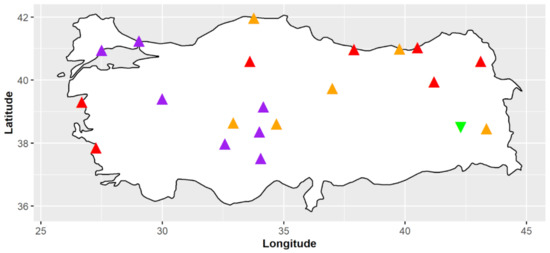
Figure 7.
Mann-Kendall trend results of TCI values for spring (See Figure 6 for legend).
Figure A16 and Table 3 show the trend analysis results of TCI values for March. It is easy to say that, like February, all trends that are statistically significant were observed as increases. Also, the remaining stations have no statistically significant trend in TCI values for March. The number of stations that have increasing trends at the 5% and 1% significance levels are eight and four for March, respectively. In other respects, eight stations have an increasing trend at the 10% significance level. According to the test results, the Tekirdag and Kumkoy stations which are in the Marmara Region have higher increases.
Figure A17 and Table 3 represents the trend results of TCI values for April. Like the previous two months, all significant trends were observed as an increase for April. Moreover, the remaining stations have no statistically significant trends in TCI values for April. There were two different significant levels for all stations. Six out of 10 stations have an increasing trend at the 10% significance level while the other stations have the trend at the 5% significance level. With respect to the test results, the Fethiye station, which is in the southwestern part of Türkiye, and the Inebolu station, which is in the Black Sea Region, have stronger increases.
Figure A18 and Table 3 show the trend analysis results of TCI values for May. It is clear that 17 stations have a decreasing trend in TCI values for May. On the other hand, three stations have an increasing trend at the 10% significance level. Besides, remaining stations have no statistically significant trend in TCI values for May. Ten out of 17 stations have a decreasing trend at the 5% significance level. The number of stations which have decreasing trends at the 10% and 1% significance levels are four and three, respectively. In terms of the test results, the Adıyaman station, which is in the Southeastern Anatolia Region, and the Antalya station, which is in the Mediterranean Region, have higher decreases.
3.2.3. Summer
Figure 8 and Table 3 indicate the trend analysis results of TCI values for the summer period. As seen from the figure, 54 out of 98 stations have a decreasing trend. On the contrary, only four stations have an increasing trend for summer. Moreover, remaining stations have no statistically significant trend in TCI values for summer. The significance levels of the decrease are 32 and 19 stations at the 1% and 5% levels, respectively. In addition, three stations have decreasing trends in TCI values at the 10% significance level. In terms of the test results, the Bursa station, which is in the Marmara Region, and the Cizre station, which is located in the Southeastern Anatolian Region, have higher decreases.
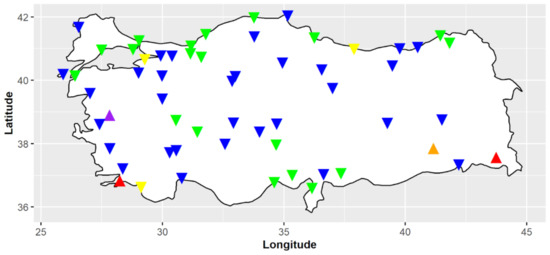
Figure 8.
Mann-Kendall trend results of TCI values for summer (See Figure 6 for legend).
Figure A19 and Table 3 represent the trend results of TCI values for June. It is clear that 47 stations have a decreasing trend during June while one station has an increasing trend. Further, 26 out of 47 stations have a decreasing trend at the 1% significance level. The number of stations which have decreasing trends at the 5% and 10% significance levels are 13 and eight, respectively. On the other hand, only one station (Batman) has an increasing trend at the 10%significance level. In addition, the remaining stations have no statistically significant trend in TCI values for June. With regard to the test results, the Esenboga Meydan station, which is located in the Central Anatolian Region, and the Antalya station, which is located in the Mediterranean Region, have stronger decreases.
Figure A20 and Table 3 indicate the trend analysis results of TCI values for July. It is easy to explain that 25 stations have a decreasing trend in TCI values during July. The number of stations which have decreasing trends at the 1% and 10% significance levels are nine and eight, respectively. On the other hand, eight stations have a decreasing trend at the 5% significance level. Moreover, six stations have an increasing trend for July. The remaining stations have no statistically significant trend in TCI values for July. With respect to the test results, the Edirne station, which is located in the Marmara Region, and Cizre station, which is located in the Southeastern Anatolian Region, hasstronger decreases. Otherwise, the Ahhisar station, which is located in the Aegean Region, and Batman station, which is located in the Southeastern Anatolian Region, have stronger increases.
Figure A21 and Table 3 express the trend analysis results of TCI values for August. Similar to the other summer months, most of the stations have a decreasing trend in TCI values for August. A total of53 stations have a decreasing trend in August, 23 of which are observed at the 1% significance level. In addition, the number of stations that have a decreasing trend at the 5% and 10% significance levels are 23 and seven, respectively. On the other hand, only two stations (Akhisar and Kilis) have an increasing trend in TCI values for August. The remaining stations have no statistically significant trend in TCI values for August. According to the test results, similar to summer, the Bursa station which is located in the Marmara Region and Cizre station which is located in the southeastern Anatolian Region have higher decreases. The Akhisar station which is located in the Aegean Region has a stronger increase like July.
3.2.4. Autumn
Figure 9 and Table 3 show the trend analysis results of TCI values for autumn. As seen from the figure and table, 30 stations have an increasing trend for the autumn period while two stations have a decreasing trend. In addition, the remaining stations have no statistically significant trend in TCI values during autumn. Out of 30, 13 stations have an increasing trend at the 10% significance level. The number of stations which have increasing trends at the 5% and 1% significance levels are 13 and four, respectively. The stations having decreasing trends are Aydın and Tatvan with 10% significance level. Considering the test results, the Izmir Bolge station, which is located in the Aegean Region, and the Cihanbeyli station, which is located in the Central Anatolian Region, have higher increases.
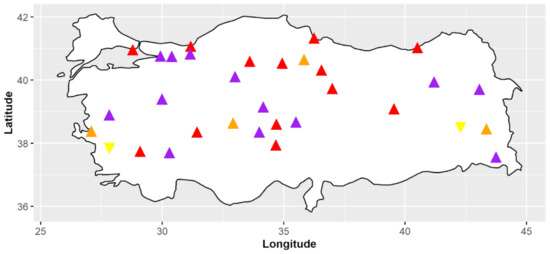
Figure 9.
Mann-Kendall trend results of TCI values for autumn (See Figure 6 for legend).
Figure A22 and Table 3 represent the trend results of TCI values for September. It is clear from the figure that 47 stations have a decreasing trend for September while three stations have an increasing trend. Additionally, the remaining stations have no statistically significant trend in TCI values during September. Twenty-five out of 47 stations have a decreasing trend at the 1% significance level. The number of stations which have decreasing trends at the 5% and 10% significance levels are 16 and six, respectively. The Akhisar station, which also has an increasing trend in August, has an increasing trend in September with 5% level of significance. In terms of the test results, the Tatvan station, which is located in the Eastern Anatolia Region, and Kastamonu station, which is located in the Black Sea Region, have higher decreases. The Ahhisar station, which is located in the Aegean Region, has a higher increase similar to the previous two months.
Figure A23 and Table 3 show the trend analysis results of TCI values for October. It is clear that 12 stations have a decreasing trend in TCI values for October. On the other hand, four stations have an increasing trend with a 5% level of significance. All increasing trends are observed in the southern parts of Türkiye. Moreover, remaining stations have no statistically significant trend in TCI values for October. Most of the decreasing trends were observed in the seaside parts of the country. There are three stations that have decreasing trends in TCI values at the 10% significance level. In addition, the number of stations having decreasing trends at the 5% and 1% significance levels are six and three, respectively. Considering the test results, the Aydin and Mugla stations which are located in the Aegean Region have stronger decreases. Otherwise, the Akcakoca and Rize stations which are in Black Sea Region have higher increases.
Figure A24 and Table 3 indicate the trend analysis results of TCI values for November. It is clear to say that 65 out of 98 stations have a decreasing trend in TCI values for November. On the other hand, no decreasing trend has been observed for all around the country. The remaining stations have no statistically significant trend in TCI values for November. Thirty out of 65 stations have increasing trends in TCI values at the 5% significance level. In addition, the number of stations having increasing trends at the 1% and 10% significance levels are 19 and 16, respectively. In regard to the test results, the Cankiri station, which is located in the Central Anatolian Region, and the Kutahya station, which is located in Aegean Region, have higher increases.
3.3. Sen Test for Four Famous Tourism Destinations
3.3.1. May
The scatter plot of the two periods (the first half of the period covers 1981–2000 and the second half of the period covers 2001–2020) of the monthly TCI during May for four famous tourism destinations is shown in Figure 10. There are four stations that have different behavior in detail but İzmir and Mugla have similar trends.For Antalya, the TCI has a decreasing trend for all the values except the highest two points. The lower and middle values are far from the identity line. For Istanbul, the TCI has an increasing trend with the values scattered through the y = 1.1x line. For İzmir, only the lowest three TCI values have an increasing trend. The other values are almost on the trend-free line. For Mugla, two points in lower TCI values fall on the increasing trend line. Five points close to the higher values have a decreasing trend. Other values are located almost on the trend-free line.
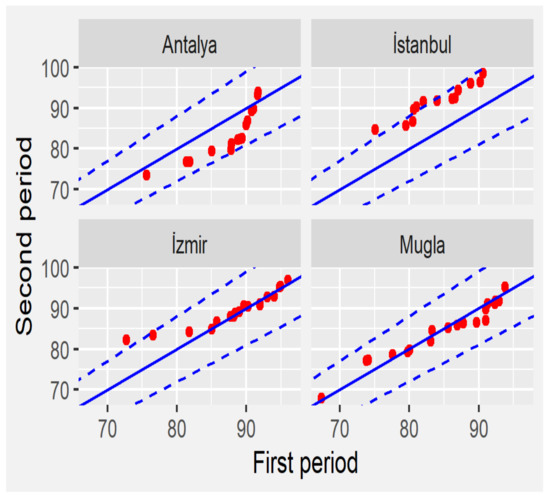
Figure 10.
Sen trend analysis of TCI of May.
3.3.2. June
The trend analysis for monthly TCI values during June classified for the stations that are famous tourism destinations can be seen in Figure 11. Antalya has a decreasing trend for almost all the data. The lowest four values are even, apart from the x = 1.1y line. The magnitude of the trend decreases by the increase of TCI values. The highest three points fall on the 1-1 line. For Istanbul, all the points fall on the increasing trend region except the lowest two points. The lowest point is in the decreasing trend region and the other one is on the 1-1 line. The points with increasing trends fall on the region surrounded by 1-1 and y = 1.1x line. For Izmır, the TCI points scatter and are not separated from the 1-1 line. Two points with a small TCI value are on the increasing trend region close to the 1-1 line. The other points display a decreasing trend region with a small magnitude in the trend. The TCI values have a decreasing trend for Mugla for all points. Three points are close to the x = 1.1y line. The other points fall on the region between 1-1 line and x = 1.1y line.
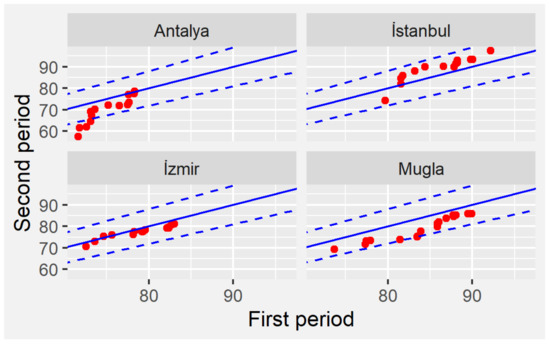
Figure 11.
Sen trend analysis of TCI of June.
3.3.3. July
The scatter plots of July TCI values for famous destinations are seen in Figure 12. As seen in the figure, Antalya has a decreasing trend for all values except the highest. Small values are located far apart from the x = 1.1y line. The remaining values are in between 1–1 line x = 1.1y line. The TCI values of Istanbul are located around the y = 1.1 line. The smallest value is in the increasing trend region while other small values are in the decreasing trend region. The medium and high values are in an increasing trend line. İzmir has a decreasing trend for small TCI values, a mixed trend for medium values and an increasing trend for high values. No values were observed out of the y = 1.1x or x = 1.1y line. For Mugla, almost all small and medium TCI pairs are in decreasing trend regions, not far apart from the 1-1 line. High values also fall into decreasing trend lines with increasing magnitude of the trend and reach the x = 1.1y line.
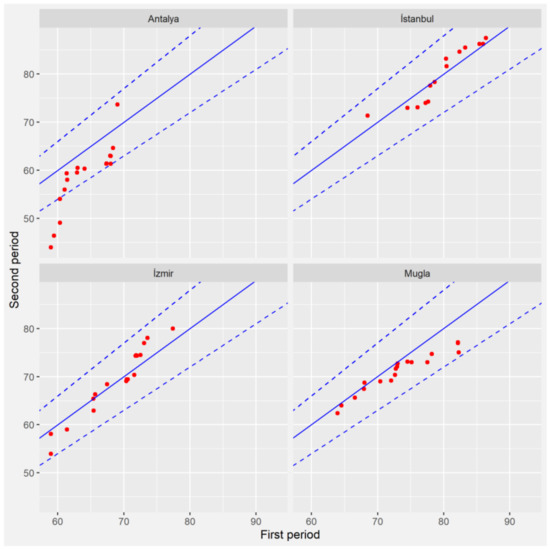
Figure 12.
Sen trend analysis of TCI of July.
3.3.4. August
The TCI values for August are seen in Figure 13. As seen in the figure, Antalya has a dramatic decreasing trend for all values except the highest two values. The small values are far apart from the x = 1.1 line which means a very high magnitude of trend. The medium values fall on the decreasing trend region surrounded by the identity line and the x = 1.1 line. August is a decreasing month for even Istanbul. Low values fall into a decreasing trend region with one value far from the x =1.1y line. Medium values are in a decreasing trend line closer to the identity line. The high values get closer to the identity line and the highest value is in the increasing trend region. Izmır has a mixed trend for TCI values in August. Small values start with a decreasing trend, pass into the increasing trend region and turn back to the decreasing trend region. The medium values have a decreasing trend. High values start with a decreasing trend and then pass into the increasing trend region. Istanbul has a decreasing trend for the lowest three values, even the lowest values fall apart from the x = 1.1y line. The following four points fall in an increasing trend region. The rest of the medium values are on the identity line. The high values are in the decreasing trend region not far from the identity line.
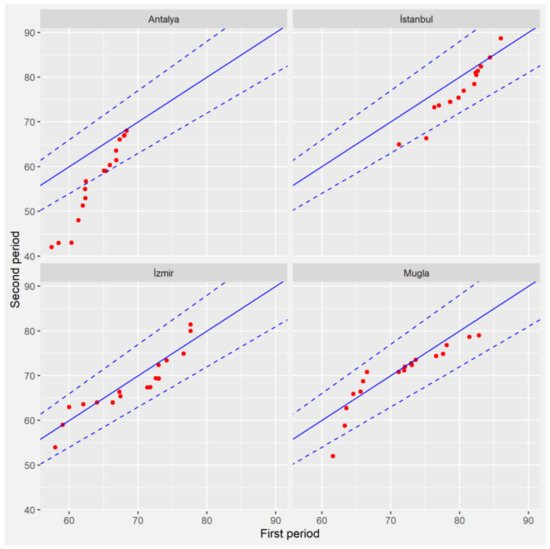
Figure 13.
Sen trend analysis of TCI of August.
3.3.5. September
Scatterplots of TCI values for September at the famous tourism destinations are seen in Figure 14. As seen in this figure, the Antalya values have a trend similar to that of August. Even so, there is no increasing trend in September. Small values fall in the decreasing trend region apart from the x = 1.1y line. The rest of the values are in the decreasing trend region between the identity line and the x = 1.1y line. Istanbul has a decreasing trend for the lowest value and two points in the middle values. The rest of the values fall on the identity line or close to the identity line in the increasing trend region. Izmir has a decreasing trend for all values with different magnitudes. The smallest two values have the highest magnitudes of decreasing trend. The rest of the values are in the decreasing trend region. Mugla has a decreasing trend for all values in the region not far from the x = 1.1 line.
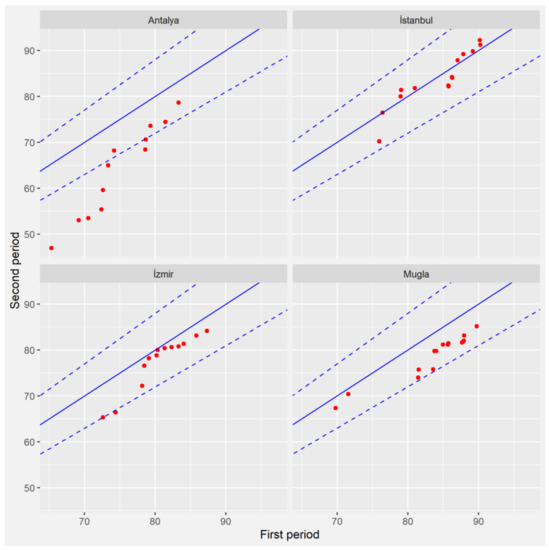
Figure 14.
Sen trend analysis of TCI of September.
4. Summary and Conclusions
On a seasonal basis, during the winter the TCI values have a pattern of increasing values from north to south except for the East Anatolia Region (lowest values) and the Black Sea Coast (greater values than southernmost inland regions). The eastern part of the Mediterranean coastline hasgreater TCI values. For spring, the entire country observed TCI values greater than 50. The TCI values are increasing from north to the south except for a few stations in the East Anatolia Region. TheMediterranean and Aegean coastlines have greater TCI values. The impact of orography is clear in both winter and summer. The summer season observed a different pattern than the winter and spring seasons. Inland regions of Türkiye have greater TCI values than coastal regions. Central Anatolia and inland parts of the Mediterranean and Aegean Region are regions with the highest TCI values. The small TCI values on the coastline are the result of high temperatures and relative humidity. During autumn, almost all the country has TCI values of “Very good” except the Black Sea coastline. Kuşadası and Çeşme are the stations with higher values. The results are consistent with Deniz (2011) that mentions the difference between coastal and inland stations during the summer.
On a monthly basis, the TCI values are highest during May in the southern part of the country, and in particular the southern part of the Aegean and Mediterranean coasts. In June, the TCI distribution pattern can be described as low TCI values in the Mediterranean Coast and South Anatolia Region, medium TCI values along the Black Sea Coast, and high TCI values found in inland areas. For July, like June, the stations in the Central Anatolia Region have higher TCI values whilst stations in the north part of the country have moderate values and the southern stations have lower values. For August, stations in inner-Anatolia have higher TCI values whilst the Black Sea Coast hasmoderate valuesand the southernmost stations have lower values. During September, the higher values are in the inland regions. However, lower TCI values are seen along both the Black Sea and Mediterranean Coast.
During the winter season, 14 stations have an increasing trend and only one has a decreasing trend. For spring, 20 stations have an increasing trend while one station has a decreasing trend. In the summer season, 54 out of 98 stations have a decreasing trend and 4 stations have an increasing trend. There were 30 stations that have an increasing trend during the autumn period while two stations have a decreasing trend. The conclusion is that while the climatic conditions are improving for most seasons, during the summer season, which is the best season climatically, tourism conditions have worsened. The details for the peak tourism season are described below.
Trend analysis for May–September should be summarized as follows: during May, 17 stations have a decreasing trend in TCI values. On the other hand, three stations have an increasing trend. For June, 47 stations have a decreasing trend while one station has an increasing trend. During July, 25 stations had a decreasing trend in TCI values. There were 53 stations that have a decreasing trend in August and only two stations have an increasing trend. For September, 47 stations have a decreasing trend while three stations have an increasing trend.
Lastly, the results of the Sen trend analysis are as follows:for May, Istanbul has an increasing TCI trend for all classes (low, moderate, and high) of TCI with a high degree of magnitude. The TCI has almost no trend except the three lowest points for Izmır. Mugla has a similar behaviour, but with some of the highest TCI class possessing decreasing trends. Antalya has a decreasing trend for all classes except the highest two points. During June, Antalya has a decreasing trend for small values with a high magnitude and the magnitude of the trend decreases with an increase in TCI values and reaches the 1-1 line for the highest class of values. For Istanbul, the TCI values have an increasing trend with the points being in between 1-1 line and the y = 1.1x line except the lowest value pair. İzmir has a mixed trend for the small value class and a decreasing trend for the higher values. Mugla has a decreasing trend in TCI for all classes. During July, Antalya has a decreasing trend for all classes except the highest value. The lowest values have a decreasing trend with high magnitude. Istanbul has a decreasing trend for the small value class and increasing trend for others with a weak trend. Izmır has a decreasing trend for small values, mixed trend for medium values and increasing trend for the high values. Mugla has a decreasing trend for almost all classes, but with a high magnitude for high value pairs. August and July are the warmest months of the year so the maximum temperatures for these months are considered for calculating CIDT. Since the CIDT is the most important component of the TCI, this index will decrease with increasing maximum temperature. Izmir has a dramatic decreasing trend for all points and, in particular, for small values. Istanbul has a decreasing trend for all values except those in the highest class. Izmır and Mugla have a mixed type of trend with the domination of a decreasing trend. September has a predominantly decreasing trend for all four famous tourism destinations. Antalya has a decreasing trend in all TCI classes with a high magnitude in the decreases for the small TCI value class. Istanbul has an increasing trend for some TCI values while the rest of them fall in the decreasing trend region. Izmır and Mugla have decreasing trends for all TCI values and all the TCI values fall in the region bounded by the y = x and the x = 1.1y line.
Further research should be conducted by using more recent indices. The TCI does have some shortcomings. Using the monthly data, the high impact of aesthetic variables over physical variables in the TCI equation are the shortcomings of the TCI. Finally, the lack of a measurable trend magnitude in the trend analysis is the main limitation of the Şen innovative trend analysis method.
Author Contributions
Conceptualization, B.E., A.D. and A.R.L.; Methodology, B.E. and A.R.L.; Software, B.E., E.Ö. and E.G.; Validation, B.E., E.Ö. and A.R.L.; Data Curation, B.E., E.G. and E.Ö.; Writing—Original Draft Preparation, B.E., E.G., E.Ö., A.R.L. and A.D.; Writing—Review & Editing, B.E., E.G., E.Ö., A.R.L. and A.D.; Visualization, B.E. and E.G. All authors have read and agreed to the published version of the manuscript.
Funding
This research received no external funding.
Data Availability Statement
The datasets used and/or analyzed during the current study are available from the corresponding author on reasonable request.
Acknowledgments
We would like to thank the Turkish State Meteorological Service for their providing the data. We also thank the three reviewers for their time and effort in helping to make this paper stronger.
Conflicts of Interest
The authors declare that they have no known competing financial interests or personal relationships that could have appeared to influence the work reported in this paper.
Appendix A
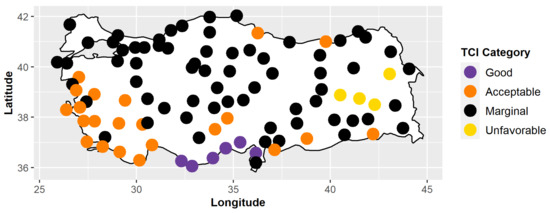
Figure A1.
TCI distribution for December.
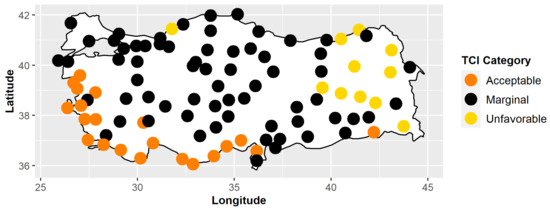
Figure A2.
TCI distribution for January.
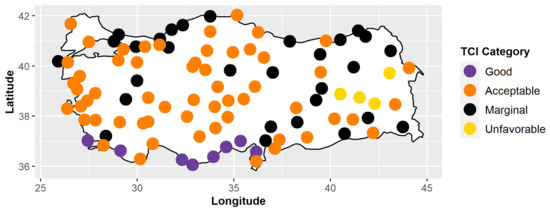
Figure A3.
TCI distribution for February.
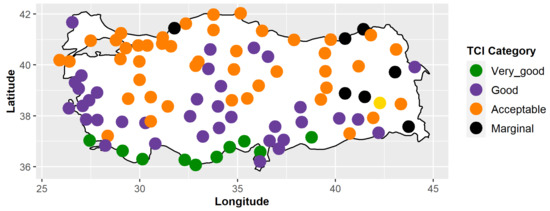
Figure A4.
TCI distribution for March.
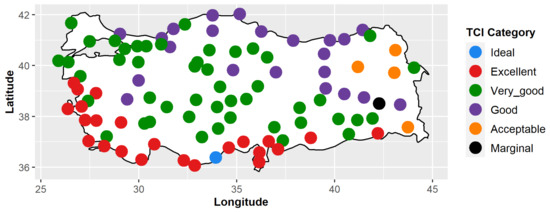
Figure A5.
TCI distribution for April.
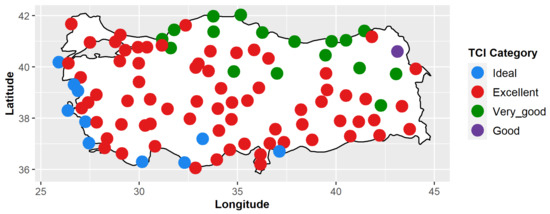
Figure A6.
TCI distribution for May.
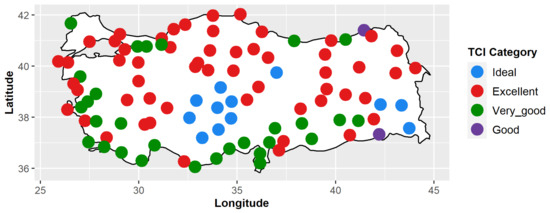
Figure A7.
TCI distribution for June.

Figure A8.
TCI distribution for July.
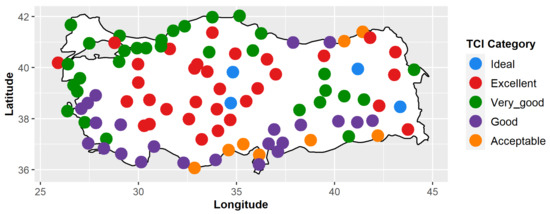
Figure A9.
TCI distribution for August.
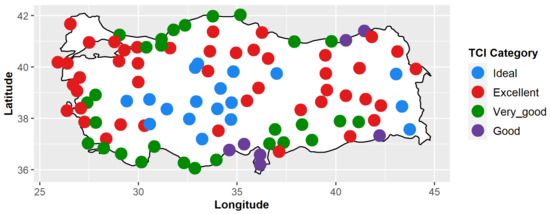
Figure A10.
TCI distribution for September.
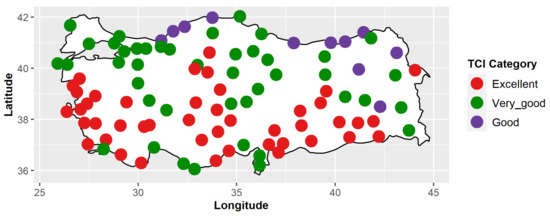
Figure A11.
TCI distribution for October.
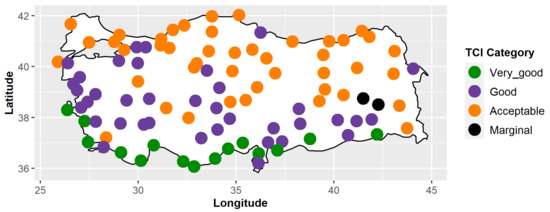
Figure A12.
TCI distribution for November.
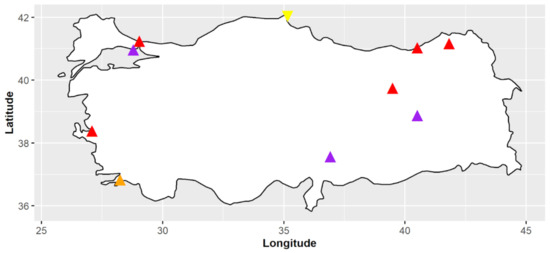
Figure A13.
Mann-Kendall trend results of TCI values for December (Red upper triangle denotes increasing trend at the 10% significance level, purple upper triangle denotes increasing trend at the 5% significance level, brown upper triangle denotes increasing trend at the 1% significance level, yellow lower triangle denotes decreasing trend at the 10% significance level, green lower triangle denotes decreasing trend at the 5% significance level and blue lower triangle denotes decreasing trend at the 1% significance level).
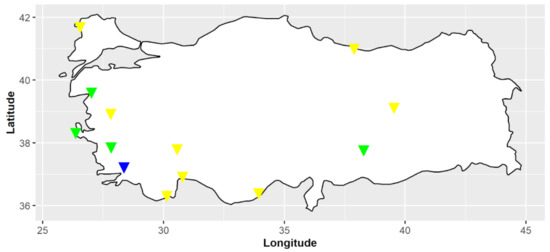
Figure A14.
Same as Figure A13 but for January (See Figure A13 for legend).
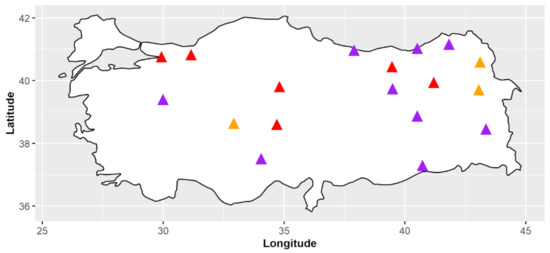
Figure A15.
Same as Figure A13 but for February (See Figure A13 for legend).
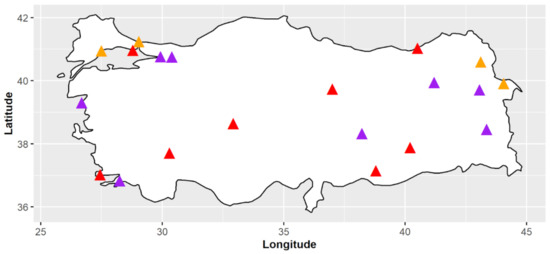
Figure A16.
Same as Figure A13 but for March (See Figure A13 for legend).

Figure A17.
Same as Figure A13 but for April (See Figure A13 for legend).
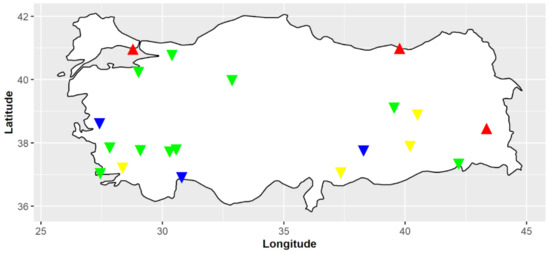
Figure A18.
Same as Figure A13 but for May (See Figure A13 for legend).
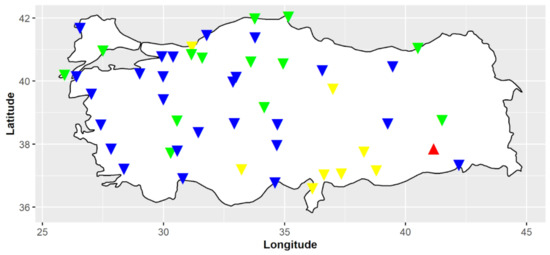
Figure A19.
Same as Figure A13 but for June (See Figure A13 for legend).
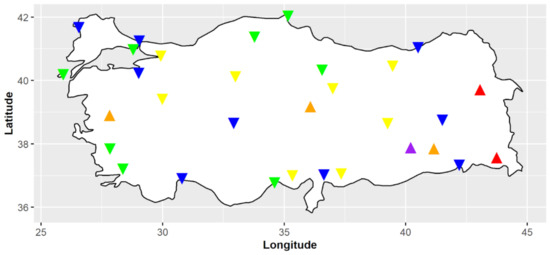
Figure A20.
Same as Figure A13 but for July (See Figure A13 for legend).
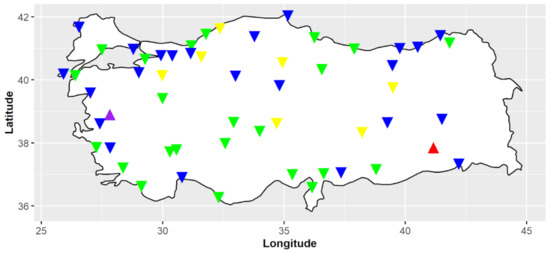
Figure A21.
Same as Figure A13 but for August (See Figure A13 for legend).
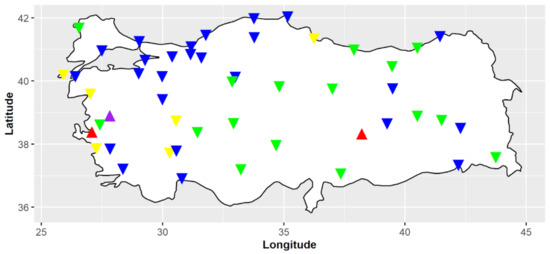
Figure A22.
Same as Figure A13 but for September (See Figure A13 for legend).
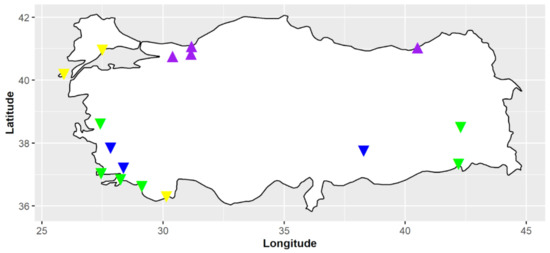
Figure A23.
Same as Figure A13 but for October (See Figure A13 for legend).
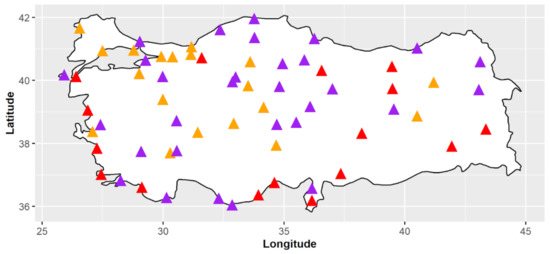
Figure A24.
Same as Figure A13 but for November (See Figure A13 for legend).
References
- Zhong, L.; Chen, D. Progress and Prospects of Tourism Climate Research in China. Atmosphere 2019, 10, 701. [Google Scholar] [CrossRef]
- UNWTO. Working Together in Europe—A Shared Leadership; UNWTO Report: Madrid, Spain, 2014. [Google Scholar]
- World Tourism Organization. World Tourism Barometer, January. Available online: https://webunwto.s3.eu-west-1.amazonaws.com/s3fs-public/2022-01/220118-Barometersmall.pdf?_PBIQdr4u_qM0w56_l0NpfGPzylGu6Md= (accessed on 17 July 2022).
- Ministry of Development. Eleventh Development Plan. Tourism Specialization Commission Report, Ankara, 140 pages. Available online: http://www.sbb.gov.tr/wp-content/uploads/2020/04/TurizmOzelIhtisasKomisyonuRaporu.pdf (accessed on 12 June 2012).
- Adiguzel, F.; BozdoganSert, E.; Dinc, Y.; Cetin, M.; Gungor, S.; Yuka, P.; Sertkaya Dogan, O.; Kaya, E.; Karakaya, K.; Vural, E. Determining the relationships between climatic elements and thermal comfort and tourism activities using the tourism climate index for urban planning: A case study of Izmir Province. Theor. Appl. Climatol. 2022, 147, 1105–1120. [Google Scholar] [CrossRef]
- Deniz, A. An Examination of the Tourism Climate Index in Turkey. Fresenius Environ. Bull. 2011, 20, 1414–1424. [Google Scholar]
- Gössling, S.; Scott, D.; Hall, C.M.; Ceron, J.P.; Dubois, G. Consumer behaviour and demand response of tourists to climate change. Ann. Tour. Res. 2012, 39, 36–58. [Google Scholar] [CrossRef]
- Roshan, G.; Yousefi, R.; Fitchett, J.M. Long-term trends in tourism climate index scores for 40 stations across Iran: The role of climate change and influence on tourism sustainability. Int. J. Biometeorol. 2016, 60, 33–52. [Google Scholar] [CrossRef]
- Li, H.; Song, H.; Li, L. A dynamic panel data analysis of climate and tourism demand: Additional evidence. J. Travel Res. 2017, 56, 158–171. [Google Scholar] [CrossRef]
- Belén Gómez Martín, M. Weather, climate and tourism a geographical perspective. Ann. Tour. Res. 2005, 32, 571–591. [Google Scholar] [CrossRef]
- Rutty, M.; Scott, D.; Matthews, L.; Burrowes, R.; Trotman, A.; Mahon, R.; Charles, A. An Inter-Comparison of the Holiday Climate Index (HCI:Beach) and the Tourism Climate Index (TCI) to Explain Canadian Tourism Arrivals to the Caribbean. Atmosphere 2020, 11, 412. [Google Scholar] [CrossRef]
- Eurobarometer 334. Attitudes of Europeans towards Tourism. European Commission. Available online: http://ec.europa.eu/public_opinion/archives/flash_arch_344_330_en.htm#334 (accessed on 13 July 2022).
- Martínez-Ibarra, E.; Gómez-Martín, M.B.; Armesto-López, X.A.; Pardo-Martínez, R. Climate Preferences for Tourism: Perceptions Regarding Ideal and Unfavourable Conditions for Hiking in Spain. Atmosphere 2019, 10, 646. [Google Scholar] [CrossRef]
- Scott, D.; Gössling, S.; de Freitas, C.R. Preferred climates for tourism: Case studies from Canada, New Zealand and Sweden. Clim. Res. 2008, 38, 61–73. [Google Scholar] [CrossRef]
- Matzarakis, A. Weather- and climate-related information for tourism. Tour. Hosp. Plan. Dev. 2006, 3, 99–115. [Google Scholar] [CrossRef]
- Mieczkowski, Z. The tourism climatic index: A method of evaluating world climates for tourism. Can. Geogr. 1985, 29, 220–233. [Google Scholar] [CrossRef]
- Amelung, B.; Nicholls, S. Implications of climate change for tourism in Australia. Tour. Manag. 2014, 41, 228–244. [Google Scholar] [CrossRef]
- Clark, D.B.; Mercado, L.M.; Sitch, S.; Jones, C.D.; Gedney, N.; Best, M.J.; Pryor, M.; Rooney, G.G.; Essery, R.L.H.; Blyth, E.; et al. The Joint UK Land Environment Simulator (JULES), Model Description—Part 2: Carbon Fluxes and Vegetation Dynamics. Geosci. Model. Dev. 2011, 4, 701–722. [Google Scholar] [CrossRef]
- Rosselló-Nadal, J. How to evaluate the effects of climate change on tourism. Tour. Manag. 2014, 42, 334–340. [Google Scholar] [CrossRef]
- De Freitas, C.R. Tourism climatology: Evaluating environmental information for decision making and business planning in the recreation and tourism sector. Int. J. Biometeorol. 2003, 48, 45–54. [Google Scholar] [CrossRef]
- Efe, B.; Lupo, A.R.; Deniz, A. The relationship between atmospheric blocking and precipitation changes in Turkey between 1977 and 2016. Theor. Appl. Climatol. 2019, 138, 1573–1590. [Google Scholar] [CrossRef]
- Efe, B.; Sezen, İ.; Lupo, A.R.; Deniz, A. The relationship between atmospheric blocking and temperature anomalies in Turkey between 1977 and 2016. Int. J. Climatol. 2020, 40, 1022–1037. [Google Scholar] [CrossRef]
- Efe, B.; Lupo, A.R.; Deniz, A. Extreme temperatures linked to the atmospheric blocking events in Turkey between 1977 and 2016. Nat. Hazards 2020, 104, 1879–1898. [Google Scholar] [CrossRef]
- Efe, B.; Gözet, E. Trend analysis of tourism climate index values in Samsun. Gümüşhane Univ. J. Sci. Technol. 2020, 11, 1164–1176. [Google Scholar] [CrossRef]
- TURKSTAT. Turkish Tourims Statistics. In Turkish Statistical Institute Database. Available online: https://data.tuik.gov.tr/Bulten/DownloadIstatistikselTablo?p=IWdxTLhd7tM1sNQcZ4erTJJRmlg1fsLpSsyAxjPoiC6kjihKnKY95KqIzlheyKG8 (accessed on 17 July 2022).
- Wang, H.; You, Q.; Liu, G.; Wu, F. Climatology and trend of tourism climate index over China during 1979–2020. Atmos. Res. 2022, 277, 106321. [Google Scholar] [CrossRef]
- Alonso-Pérez, S.; López-Solano, J.; Rodríguez-Mayor, L.; Márquez-Martinón, J.M. Evaluation of the Tourism Climate Index in the Canary Islands. Sustainability 2021, 13, 7042. [Google Scholar] [CrossRef]
- ASHRAE. ASHRAE Handbook of Fundamentals American Society of Heating, Refrigerating and Air Conditioning Engineers; ASHRAE: New York, NY, USA, 1972. [Google Scholar]
- Mann, H.B. Non-Parametric Tests against Trend. Econometrica 1945, 13, 245–259. [Google Scholar] [CrossRef]
- Kendall, M.G. Rank Correlation Methods; Charles Griffin: London, UK, 1975. [Google Scholar]
- Şen, Z. Innovative Trend Analysis Methodology. J. Hydrol. Eng. 2012, 17, 1042–1046. [Google Scholar] [CrossRef]
- Efe, B.; Lupo, A.R. Global Trends in the Occurrence and Characteristics of Blocking Anticyclones using Şen Innovative Trend Analysis. Theor. Appl. Climatol. 2022, 150, 763–776. [Google Scholar] [CrossRef]
- Meng, Q.; Bai, H.; Sarukkalige, R.; Fu, G.; Jia, W.; Zhang, C. Annual and seasonal precipitation trends and their attributions in the Qinling Mountains, a climate transitional zone in China. Theor. Appl. Climatol. 2021, 144, 401–413. [Google Scholar] [CrossRef]
- Dabanlı, İ.; Şen, Z.; Yeleğen, M.Ö.; Sisman, E.; Selek, B.; Güçlü, Y.S. Trend Assessment by the Innovative-Şen Method. Water Resour. Manag. 2016, 30, 5193–5203. [Google Scholar] [CrossRef]
- Pandey, B.K.; Khare, D.; Tiwari, H.; Mishra, K.M. Analysis and visualization of meteorological extremes in humid subtropical regions. Nat. Hazards 2021, 108, 661–687. [Google Scholar] [CrossRef]
- Wickham, H. Ggplot2: Elegant Graphics for Data Analysis; Springer: New York, NY, USA; Available online: http://ggplot2.org (accessed on 17 July 2022).
- R Core Team. R: A Language and Environment for Statistical Computing; R Foundation for Statistical Computing: Vienna, Austria, 2020; Available online: https://www.R-project.org/ (accessed on 10 August 2022).
- Wickham, H.; Francios, R.; Henry, L.; Müller, K.; Dplyr, K.M. A Grammar of Data Manipulation. R package Version 1.0.7. Available online: https://cran.r-project.org/package=dplyr (accessed on 17 July 2022).
Publisher’s Note: MDPI stays neutral with regard to jurisdictional claims in published maps and institutional affiliations. |
© 2022 by the authors. Licensee MDPI, Basel, Switzerland. This article is an open access article distributed under the terms and conditions of the Creative Commons Attribution (CC BY) license (https://creativecommons.org/licenses/by/4.0/).